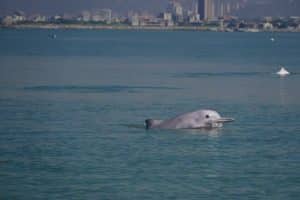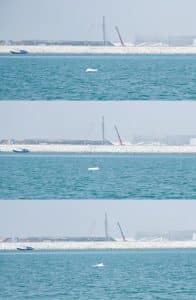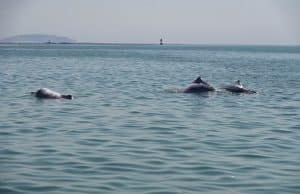On the 13th May, tranquility in Weitou Bay, Quanzhou, Fujian, was shattered by underwater explosions as part of a planned port construction project. This reef blasting aimed to clear undersea rock formations for ship channels, restarting after a long stall since its initial launched in 2005 and becoming a key costal initiative for Fujian since 2022. The project underwent Environmental Impact Assessment (EIA), a critical mechanism meant to safeguard biodiversity against human development.
The choice of blasting site stirred controversy due to its designation as a critical habitat and breeding ground for the critically endangered Chinese white dolphin. Known as the “giant panda of the sea,” these rare marine mammals are distinguished by their pale pink appearance, intensifying with age. Chinese white dolphins inhabit coastal waters in southern China, relying on echolocation for communication, navigation, and hunting. Their population has sharply declined due to habitat loss, pollution, ship traffic, and underwater noise. Recognized under China’s highest protection class, their conservation symbolizes marine biodiversity and ecological balance.
The reef blasting, conducted without prior warning during the dolphins’ mating season, poses risks of mortality, hearing impairment, and disruption to their echolocation systems, as highlighted by Nature of Friends, a proactive social organization.

Environmental Oversight
The Quanzhou Environmental Protection Bureau defended the project’s location, citing its distance—7.9 kilometers from the nearest dolphin reserve and 6.08 kilometers from the outer buffer zone of the Xiamen National Rare Marine Species Protection Area—as evidence that construction-related sediment and noise would have only a minor effect. When asked whether dolphins had been observed in the area, officials responded that “None have been recorded during the past year.” However, the absence of recorded sightings does not prove absence; it may simply reflect insufficient monitoring.
This explanation is overly simplistic and dangerously misleading. Marine ecosystems are fluid and interconnected, not bound by man-made borders. Dolphins do not adhere to reserve boundaries; their feeding and breeding grounds often extend beyond such lines. Using arbitrary distance measurements to assess risk fails to reflect the realities of ecological systems and risks underestimating the actual threat to marine life.
Lessons Unlearned
This incident echoes previous tragedies where dolphins suffered during developmental projects, such as the construction of Xiamen Xiang’an International Airport in 2015, which failed to provoke lasting policy changes.
Recently, the Taishan municipal government’s decision to redraw boundaries around the Jiangmen Chinese White Dolphin Provincial Reserve, reducing its protected area, further illustrates challenges in balancing development and conservation.

Necessary Reforms
- Reform of Environmental Impact Assessments (EIAs):
Enhance EIAs with real-time monitoring, independent expert reviews, and extended public consultation periods. - Mandatory Mitigation Measures:
Introduce guidelines for mitigating ecological damage during potentially harmful activities like reel blasting, including soft-start procedures and seasonal restrictions. - Transparent Public Participation
Extend public disclosure periods beyond current minimal durations, ensuring robust community and NGO involvement in development reviews. - Recognition of Ecological Value:
Acknowledge the ecological significance of marine species and habitats as integral to sustainable development. - Accountability Mechanisms: Implement strict consequences for environmental harm, holding stakeholders accountable for responsible practices.
The Bigger Picture: A Crisis of Priorities
The Weitou Bay incident underscores deeper conflicts between ecological preservation and economic growth. Environmental considerations are often sidelined as bureaucratic formalities, prioritizing economic gains over biodiversity conservation. However, healthy marine ecosystems provide indispensable services like fisheries, carbon sequestration, and shoreline protection, crucial for sustainable economic development.
Call for Action
Amidst global environmental challenges, we must prioritize long-term sustainability over short term gains. China’s regulatory efforts, like the Regulation on Ecological and Environmental Protection Inspection, offer a framework for stringent environmental oversight and public engagement, crucial in safeguarding biodiversity and promoting responsible development practices.

Conclusion
The neglect of Chinese white dolphins in Weitou Bay is a stark reminder of the urgent need for conscientious environmental stewardship. As custodians of our planet’s natural heritage, we must ensure that economic progress respects ecological boundaries. Only through collective action and stringent regulations can we mitigate the impact of development on fragile marine ecosystems, preserving biodiversity for future generations.
Resources:
Liming Yong, Yuke Zhang, Liyuan Zhao, Qianhui Zeng, Longshan Lin, Minhao Gao, Hao Cheng, Xianyan Wang. Research advances on the ecology of Sousa chinensis[J]. Biodiv Sci, 2023, 31(5): 22670.



